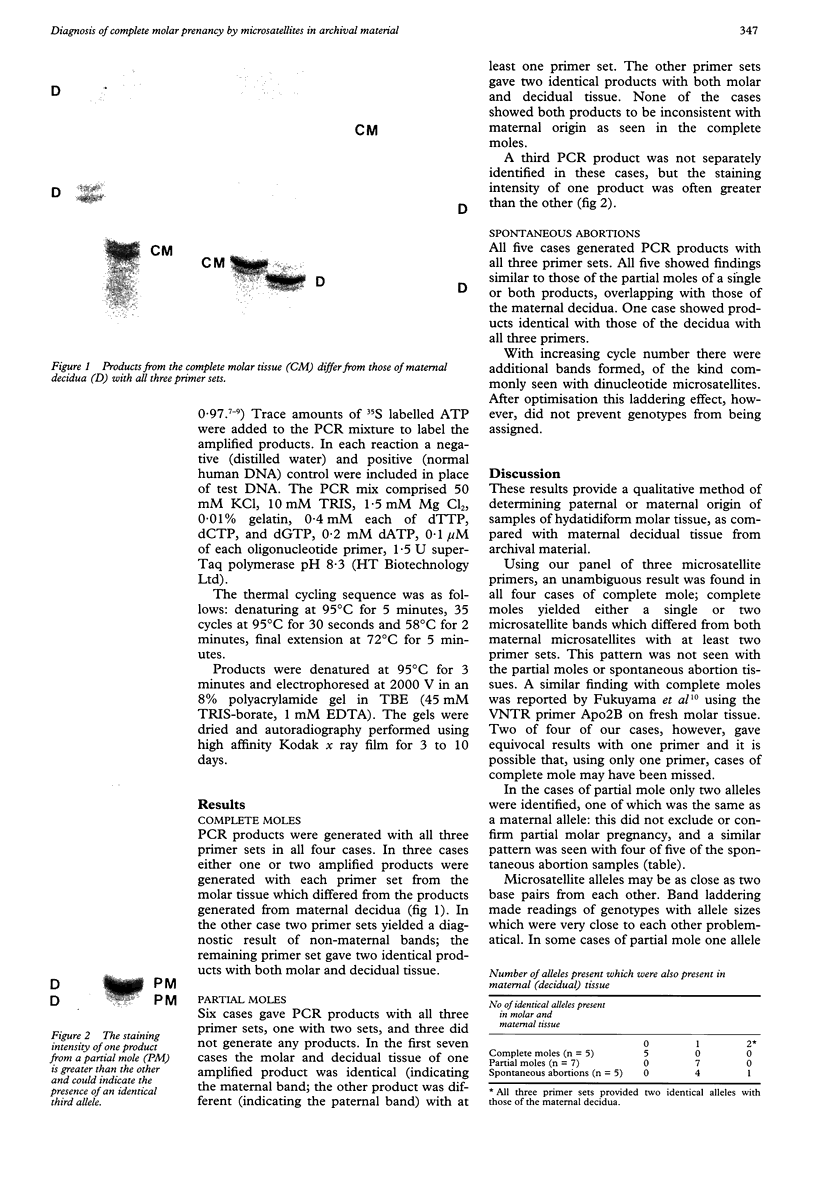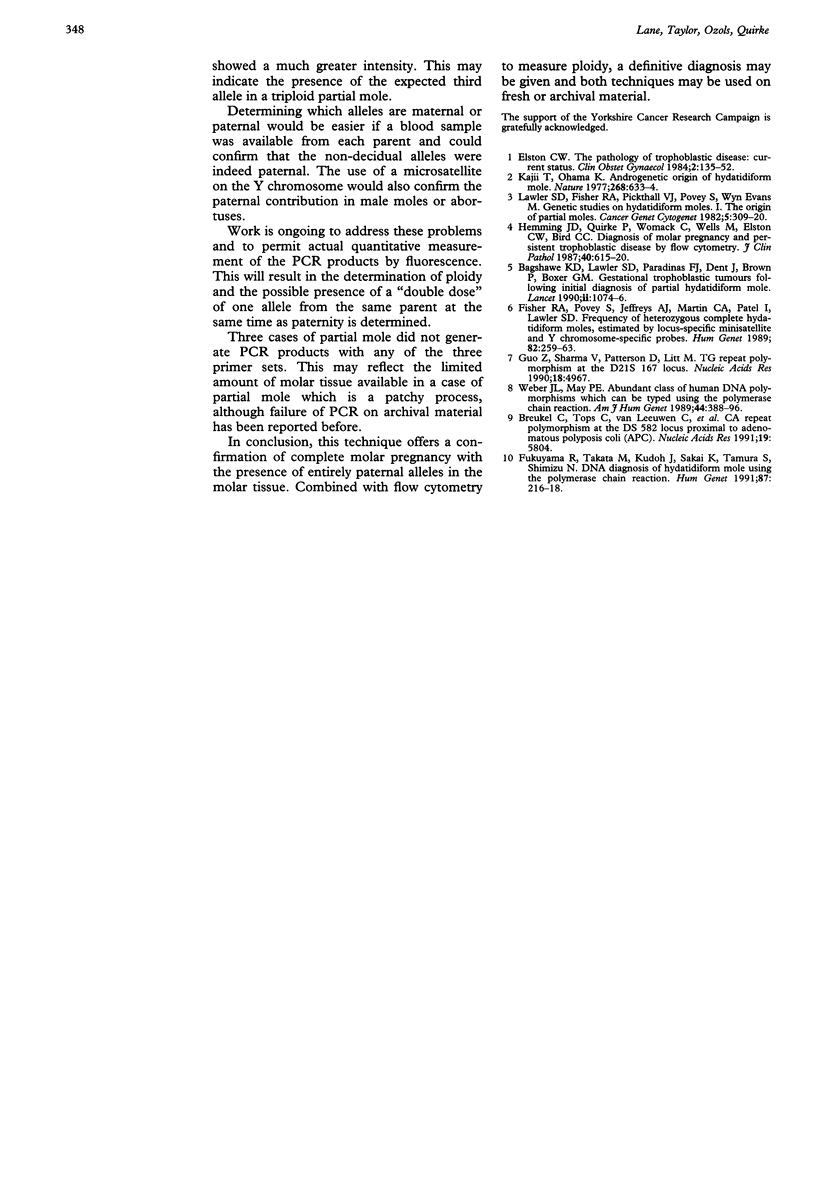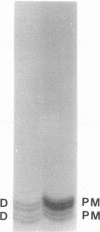Abstract
AIMS--To develop an assay which would determine the parentage of hydatidiform molar pregnancies. METHODS--DNA was extracted from formalin fixed, paraffin wax embedded tissue from hydatidiform molar pregnancies and spontaneous abortions after separation of chorionic villi and decidua. PCR amplification of dinucleotide repeat sequences ("microsatellites") was performed using three different primers. Products were radioactively labelled and visualised by autoradiography of dried polyacrylamide gels. RESULTS--With informative microsatellites, diagnostic patterns of amplification were obtained. Complete moles yielded either one or two microsatellites which differed from both maternal (decidual) microsatellites. Complete mole could be excluded by all the microsatellites showing alleles identical with those in maternal DNA. CONCLUSIONS--This technique offers a method of determining the presence of entirely paternal alleles in a molar pregnancy and thus confirming a complete hydatidiform mole.
Full text
PDF


Images in this article
Selected References
These references are in PubMed. This may not be the complete list of references from this article.
- Bagshawe K. D., Lawler S. D., Paradinas F. J., Dent J., Brown P., Boxer G. M. Gestational trophoblastic tumours following initial diagnosis of partial hydatidiform mole. Lancet. 1990 May 5;335(8697):1074–1076. doi: 10.1016/0140-6736(90)92641-t. [DOI] [PubMed] [Google Scholar]
- Breukel C., Tops C., van Leeuwen C., van der Klift H., Nakamura Y., Fodde R., Khan P. M. CA repeat polymorphism at the D5S82 locus, proximal to adenomatous polyposis coli (APC). Nucleic Acids Res. 1991 Oct 25;19(20):5804–5804. doi: 10.1093/nar/19.20.5804. [DOI] [PMC free article] [PubMed] [Google Scholar]
- Elston C. W. The pathology of trophoblastic disease: current status. Clin Obstet Gynaecol. 1984 Apr;11(1):135–152. [PubMed] [Google Scholar]
- Fisher R. A., Povey S., Jeffreys A. J., Martin C. A., Patel I., Lawler S. D. Frequency of heterozygous complete hydatidiform moles, estimated by locus-specific minisatellite and Y chromosome-specific probes. Hum Genet. 1989 Jun;82(3):259–263. doi: 10.1007/BF00291166. [DOI] [PubMed] [Google Scholar]
- Fukuyama R., Takata M., Kudoh J., Sakai K., Tamura S., Shimizu N. DNA diagnosis of hydatidiform mole using the polymerase chain reaction. Hum Genet. 1991 Jun;87(2):216–218. doi: 10.1007/BF00204186. [DOI] [PubMed] [Google Scholar]
- Guo Z., Sharma V., Patterson D., Litt M. TG repeat polymorphism at the D21S167 locus. Nucleic Acids Res. 1990 Aug 25;18(16):4967–4967. doi: 10.1093/nar/18.16.4967-a. [DOI] [PMC free article] [PubMed] [Google Scholar]
- Hemming J. D., Quirke P., Womack C., Wells M., Elston C. W., Bird C. C. Diagnosis of molar pregnancy and persistent trophoblastic disease by flow cytometry. J Clin Pathol. 1987 Jun;40(6):615–620. doi: 10.1136/jcp.40.6.615. [DOI] [PMC free article] [PubMed] [Google Scholar]
- Kajii T., Ohama K. Androgenetic origin of hydatidiform mole. Nature. 1977 Aug 18;268(5621):633–634. doi: 10.1038/268633a0. [DOI] [PubMed] [Google Scholar]
- Lawler S. D., Fisher R. A., Pickthall V. J., Povey S., Evans M. W. Genetic studies on hydatidiform moles. I. The origin of partial moles. Cancer Genet Cytogenet. 1982 Apr;5(4):309–320. doi: 10.1016/0165-4608(82)90096-6. [DOI] [PubMed] [Google Scholar]
- Weber J. L., May P. E. Abundant class of human DNA polymorphisms which can be typed using the polymerase chain reaction. Am J Hum Genet. 1989 Mar;44(3):388–396. [PMC free article] [PubMed] [Google Scholar]




